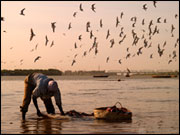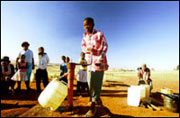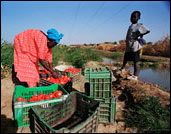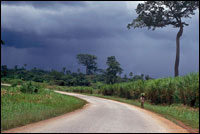Joint report: Water and the Rural Poor
Interventions for improving livelihoods in sub-Saharan Africa
 FAO and IFAD have recently produced a report where they argue about the existing potentials for well-targeted, local interventions in water that can contribute to the rapid improvement in the livelihoods of the rural poor in SSA.
FAO and IFAD have recently produced a report where they argue about the existing potentials for well-targeted, local interventions in water that can contribute to the rapid improvement in the livelihoods of the rural poor in SSA.
The same interventions that can help attaining the Millennium Development Goal of eradicating extreme poverty and hunger.
There are important opportunities for new investments in water but their success depend on the development of new models of interventions, centered on enhancing the diversity of livelihood conditions of rural populations.
There is no “one size fits all” approach for improving livelihoods. Different contexts and needs require different types of investments to guide the choice for specific interventions.Rural water pump near Ulundi.South Africa. Photo: Trevor Samson / World Bank
 Sub-Saharan Africa can be divided in 13 major “livelihood zones”. Each zone offers distinct opportunities for livelihood sustenance and development, has different agro-ecological conditions, and shows different angles for water-related investments for poverty reduction.
Sub-Saharan Africa can be divided in 13 major “livelihood zones”. Each zone offers distinct opportunities for livelihood sustenance and development, has different agro-ecological conditions, and shows different angles for water-related investments for poverty reduction.
A closer observation also shows the differences of rural poor distribution across the livelihood zones, with high prevalence of relative poverty in the highlands of Ethiopia, the Lake Victoria basin, parts of Nigeria and in the semi-arid and sub-humid areas.
The types of interventions required rarely involve large-scale irrigation schemes, although there is a need to improve those already existing, when these systems are used below capacity and are poorly maintained. In all cases, clear policies need to be put in place to allow equitable access to the water by poor farmers, who also require favorable market linkages and conditions.Harvesting tomatoes. Sengal.

The report’s main focus is on small-scale on-farm improvements, structures that are easy to operate and maintain locally and that target mainly female and male smallholders. Such interventions will focus in particular on improving water management in rainfed agriculture.
Investments in water infrastructure alone cannot suffice to improve agricultural productivity in SSA. Farmers need secure access to inputs including fertilizer, better seeds, and credit. They need to be better educated and informed on the use of inputs and the latest techniques.
Investments in water control need to be planned and implemented in the much broader framework of agricultural and rural development, where production, markets, finance and infrastructure are conceived in an integrated way and are mutually supporting. Furthermore, the policy and institutional framework has to ensure fair and equitable access to water resources and effective access to markets for agricultural products.
 Climate change represents an additional challenge to rural people in SSA, and a further reason for investment in water control. In view of their limited adaptive capacity, smallholder farmers, pastoralists and artisanal fishers in SSA are among the most vulnerable to the impact of climate change. While projections on possible changes in annual rainfall vary across Africa, these populations will experience the negative effects of increased temperature on yields, combined with a high vulnerability to extreme events. For them, enhanced control of water will become critical in building resilience to increased climate variability.
Climate change represents an additional challenge to rural people in SSA, and a further reason for investment in water control. In view of their limited adaptive capacity, smallholder farmers, pastoralists and artisanal fishers in SSA are among the most vulnerable to the impact of climate change. While projections on possible changes in annual rainfall vary across Africa, these populations will experience the negative effects of increased temperature on yields, combined with a high vulnerability to extreme events. For them, enhanced control of water will become critical in building resilience to increased climate variability.
